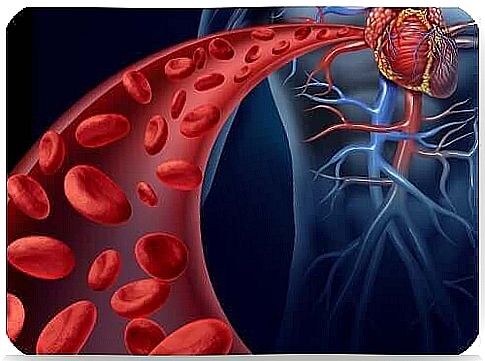Abdominal Aortic Aneurysm: Symptoms And Treatment

Abdominal aortic aneurysm is an abnormal and persistent enlargement of the aortic blood vessel. It is a condition that can affect any person and have serious consequences.
Older adults are at greater risk of suffering from this disease because the artery walls are looser and more elastic. Similarly, there have been cases among young people, which have to do with genetic problems and secondary conditions that lead to this problem.
In this article, we will take a closer look at this condition.
What is abdominal aortic aneurysm?
The main artery (aorta) is the largest artery in the entire human body. It begins on the left side of the heart and is responsible for transporting blood to the entire body.
So what are we talking about when we refer to abdominal aortic aneurysm?
This is the part of this artery that crosses the abdomen, just in front of the spine. It extends from the diaphragm down to the fourth lumbar vertebra.
On the other hand, an aneurysm means that an area of the artery expands. In other words, the walls of the blood vessel are dilated and weakened, and have a greater risk of rupture.
It is important to remember that we are talking about the blood vessel with the largest caliber in the whole body. In other words, it transports more blood and with more pressure than any other blood vessel. Therefore, the risk of a rupture is a major source of concern for those with aortic aneurysm.

Risk factors for abdominal aortic aneurysm
Although this can occur in any person, certain factors or habits increase a person’s risk. Similarly, there are risk factors that increase the risk of rupture in patients with an aneurysm.
These factors include the following:
- Men are four times more likely to develop an aneurysm than women.
- A family history of aneurysm. There are certain genetic factors involved in the inheritance of this disease.
- Smoking. Tobacco has many harmful effects on the body. Among these, toxins that are ingested while smoking cause the blood vessels to become stiffer and fragile. This increases the chance of a rupture in a person with an aneurysm.
- High cholesterol and atherosclerosis . Just like tobacco, both of these factors damage the artery walls, making them more prone to cracking.
- High blood pressure. In cases of hypertension, the blood circulates with more pressure in the arteries. This pressure is transmitted directly to the vessel walls and forces them to be more resistant.
What are the symptoms of abdominal aortic aneurysm?
In general, these aneurysms develop slowly over time. It is very rare that they develop quickly. However, if a crack occurs, the situation becomes urgent and can mark the beginning and discovery of the disease.
During the slow development there are no symptoms. When a crack occurs, it may be small. Symptoms may appear and then gradually worsen over time. In the case of a large crack, the symptoms will come faster.
Some symptoms are as follows:
- Abdominal pain that may radiate to the lower back
- A reduction in blood pressure
- Dizziness or fainting
- Cold sweat
- Difficulty breathing and accelerated heart rate

Diagnosis and treatment
If the aneurysm does not rupture, the discovery usually occurs by chance during diagnostic imaging. This can happen, for example, during an ultrasound, CT scan or X-ray due to another problem.
Once the diagnosis is made, the treatment involves preventing cracks and will depend on the size of the aneurysm. Some methods include strict blood pressure control and regulation of cholesterol levels. Of course, doctors encourage patients with aneurysms to stay away from tobacco.
In some cases, it is best to treat an aneurysm surgically. For example, if an aneurysm is large or growing rapidly. The same applies if a patient presents many risk factors that can lead to fractures.
Finally, if an aneurysm has already ruptured, an emergency operation is necessary.
The risk of rupture
Abdominal aortic aneurysm is a condition that occurs with a frequency that we should not take lightly. If diagnosed early, patients can usually avoid complications through preventive treatment and close monitoring.
If, on the other hand, the abdominal aorta ruptures, prompt diagnosis and acute surgery will be necessary to avoid a fatal situation. Keeping your blood pressure under control, lowering your blood cholesterol levels and avoiding tobacco are essential to prevent harm.









